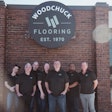
In 2018, our family retail flooring business went paperless. It wasn’t an easy decision at the time, but it ultimately made us more efficient. By the time the pandemic hit in 2020 and businesses were shut down or working remotely, we were able to work from home and continue servicing our customers without having to be in the office and needing the physical paperwork. Here’s how we made the decision to go paperless, how it works for us, and how we keep our business one step ahead with technology.
1) We monitor our own consumer patterns
Our company really started investing in technology in 2008 when the market crashed. At that time, having a company website was a new thing, and it allowed us to feature the brands we carry and educate the consumer on the specifics of each product—including consumers outside of a 25-mile radius. We decided what technology to invest in by simply observing our own behaviors as consumers. For instance, I noticed that I would find a pair of shoes online and track it down at the local Nordstrom rather than using the traditional in-store shopping method. Noticing how we shop and search for products, and the technology used by other retail stores, we made changes and adjustments to push our business forward.
2) We moved sales transactions to the cloud
Paperless for our company means that everything pertaining to a sale transaction is saved in one digital place—the cloud. We used to keep boxes and boxes of paper records for years. Although our files were organized, it was still a hassle to handle physical boxes and look for a particular invoice or purchase order pertaining to a claim.
With our digitized system, however, having price lists and invoices emailed saves time, makes us more efficient and accurate and ensures that everything is up to date. It also eliminates the clutter of paper and pricing binders.
I will confess that I kept my pricing book up to date for way longer than necessary for fear the technology would fail me. At that time, it seemed to me that I could look up a price rather quickly in my book, as I was used to the process we had in place. But looking back, I am so glad we implemented the digital price lists, invoices and order confirmations. It helps that the driver of these processes here is a Millennial himself (shout out to my brother Ben), who is always creating new ways to make us more efficient and accurate.
3) We introduced a CRM operating platform
In recent years, we have also introduced a mobile app for our website, a CRM (customer relation management) operating platform where each conversation is tracked from start to completion of the order with a paperless signing process for orders and delivery. The CRM is something we can access from anywhere, and it makes it easier to know what stage of the sales process we’re at with the customer. Anyone who talks to the customer makes their notes for the appropriate department to see. It’s been a convenient way to recall our previous interactions and conversations with the customer. By recalling and mentioning the personal events in the client’s life, such as a vacation, a new baby, an escrow closed, etc., we add a human touch to our interactions.
4) We manage the generational differences of clients
The largest group of people with buying power today are Millennials. Implementing technology for digital natives has proven to be a win-win for us and the consumer. The ease of the transaction from their desktop or a mobile device with a few clicks has made them feel like we speak their language. Our job is to make their life easier, and having a process that is straightforward helps ease their already stressful remodeling project. There are a few challenges, of course, with the older generations. At times, we are required to put our guide hats on and walk the customer through the documents they are viewing and clicking on.
5) We let technology work 24/7 for us
When we are closed for business, people are online learning, researching and making flooring decisions. So, to meet them where they’re at, along with our website, we have also been creating educational videos for our YouTube channel. The purpose is to disseminate information and education on a larger scale. One-on-one, I can only reach so many people. The technology and our social media platforms allow us to have a further reach and work for us 24/7.
While there is a cost to all this technology, in any business, if you’re not moving forward, you’re falling backward. It has become a necessary part of growing a successful business. I would advise any business to consistently review their processes and procedures. Technology changes at lighting speed—and, as with the past two years, you never know when it’s going to be critical for your business. There are so many creative people making life easier for us these days. At the end of the day, we are not here to shuffle papers and waste time looking for information.

































